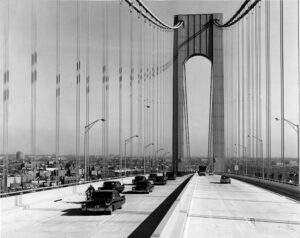The Verrazzano-Narrows Bridge opened 60 years ago today, on Nov. 21, 1964, connecting Staten Island and Brooklyn and forever changing the histories of both boroughs.
Depending on one’s perspective, it’s either a vital connection between two New York boroughs or the bridge that ruined Staten Island.
It was the world’s largest suspension when it opened, spanning 9,865 feet between abutments. Today, it is the longest suspension bridge in North America.
“The Verrazzano-Narrows Bridge, now in its 60th year, remains the longest suspension bridge in the Americas and one of the most used bridges in the metro area, handling over 200,000 vehicles every day,” Metropolitan Transportation Authority Bridges and Tunnels President Catherine Sheridan said in a release. “As a critical connecter between Staten Island and Brooklyn, and a key component for regional commerce, we’re committed to keeping the bridge in excellent condition for decades to come.”
Designed by civil engineer Othman Amman, the engineering marvel carried more than 80 million vehicles in 2023.
The bridge is named for Giovanni da Verrazzano. In 1524, he was the first European explorer to sail into New York Harbor.
Construction started on Aug. 13, 1959, and its name was initially misspelled Verrazano. The bridge has 13 traffic lanes: six lanes on the upper level — three in each direction — a reversible seventh bus/HOV lane, and six lanes — three in each direction — on the lower level.
Its iconic 693-foot-high towers are 1-5/8 inches further apart at their tops than at their bases because the 4,260-foot distance between them made it necessary to compensate for the earth’s curvature. Each tower weighs 27,000 tons and is held together with three million rivets and one million bolts.
Seasonal contractions and expansions of the steel cables cause the double-decked roadway to be 12 feet lower in the summer than in the winter.

